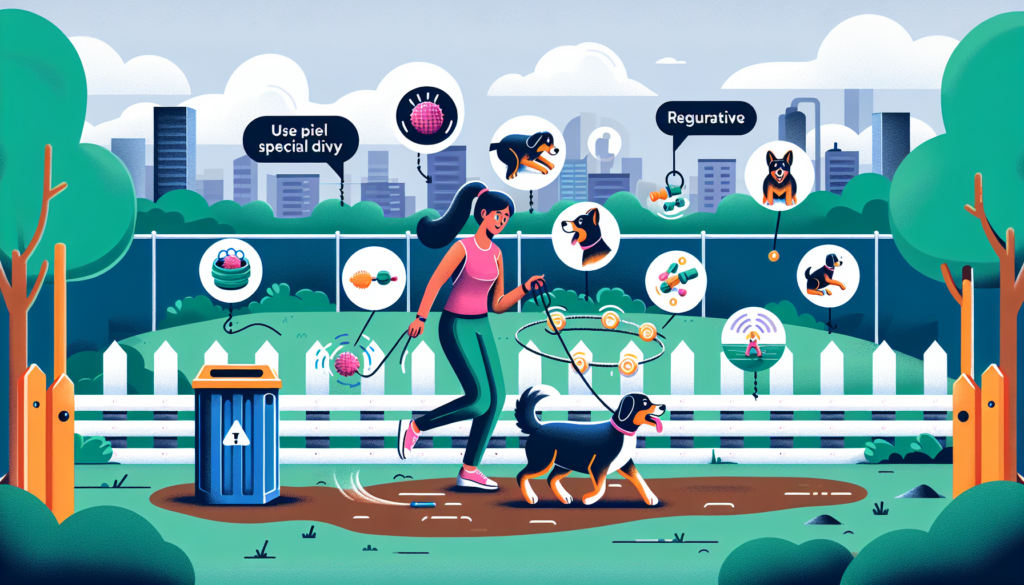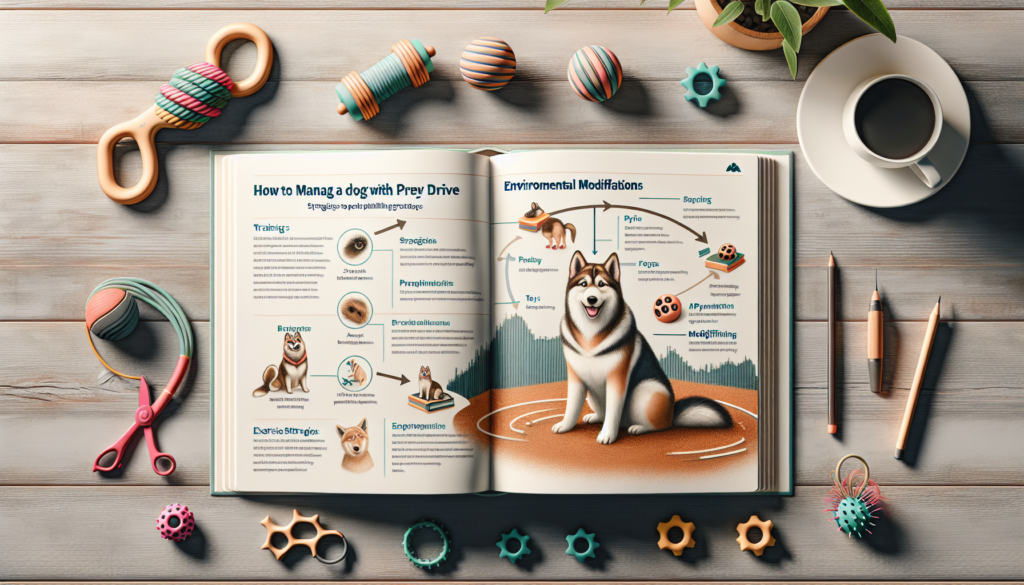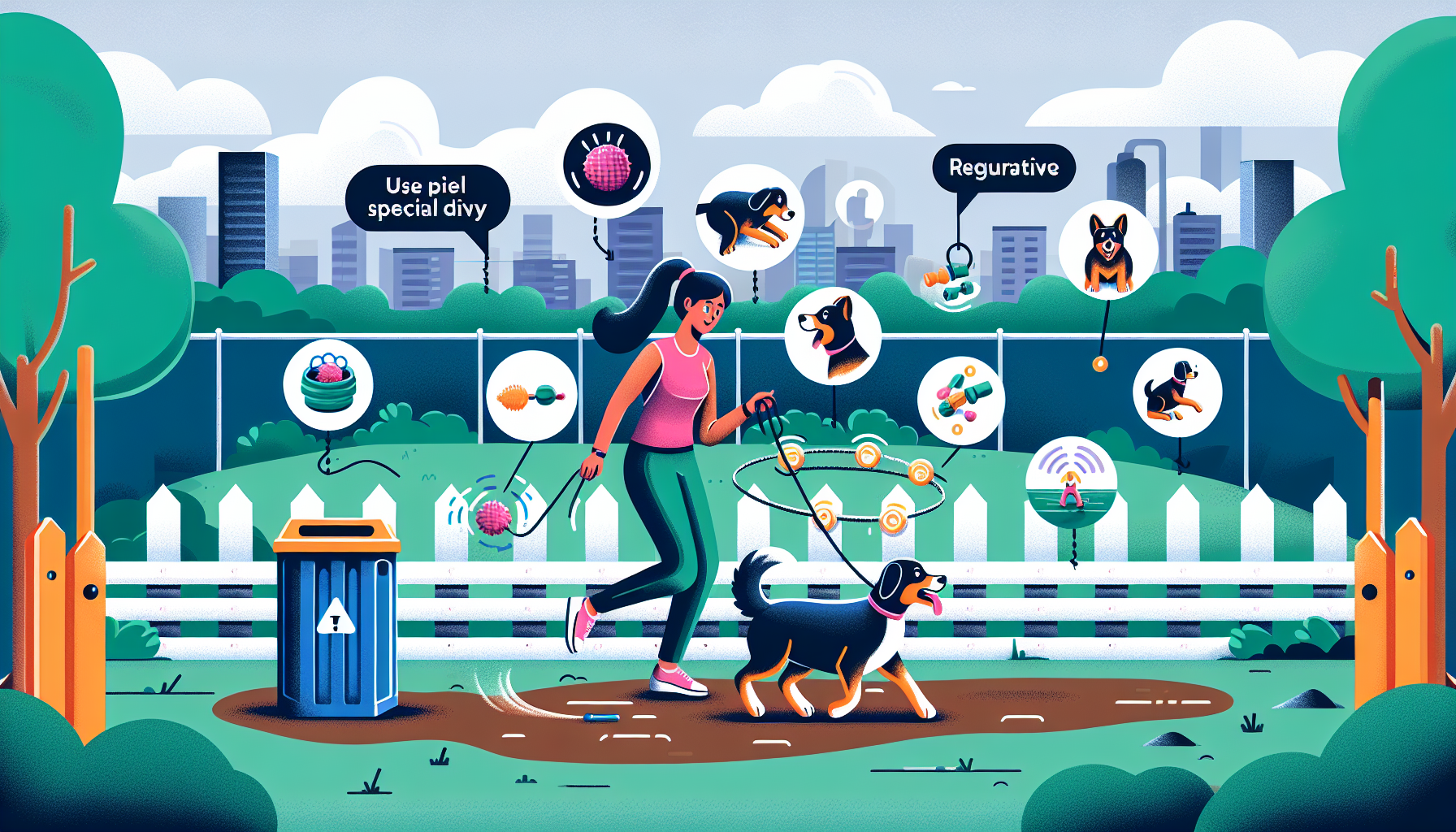Managing a dog with high prey drive can be a challenging task, but with the right knowledge and techniques, you can create a harmonious and safe environment for both your pet and those around them. This article provides valuable tips and strategies that will help you understand and manage your dog’s natural instinct to chase and hunt. From creating a secure and stimulating environment to providing appropriate outlets for their energy, these tips will ensure a happy and well-adjusted dog with a high prey drive.
Understanding Prey Drive
Definition of Prey Drive
Prey drive refers to an inherent instinct in dogs that compels them to chase and capture prey. It is an instinct deeply rooted in their DNA and varies in intensity from one dog to another. Dogs with high prey drive are often motivated by movement, whether it’s a fleeing squirrel, a fast-moving cyclist, or a fluttering butterfly.
Common Breeds with High Prey Drive
While prey drive can be found in dogs of all breeds and mixed breeds, there are certain breeds that are known for having a higher prey drive. Some common examples include the Border Collie, Australian Shepherd, Jack Russell Terrier, and Greyhound. These breeds were traditionally bred for specific purposes, such as herding, hunting, or coursing prey, which has contributed to their heightened prey drive.
Signs of High Prey Drive in Dogs
Identifying signs of high prey drive in your dog is essential in managing their behavior effectively. Some common signs include intense focus on moving objects, quick and sudden movements in response to stimuli, a strong desire to chase and capture, and a tendency to display predatory behavior, such as stalking or pouncing. It’s important to note that prey drive can manifest differently in different dogs, so being familiar with your dog’s specific behaviors is key.
Training and Socialization
Importance of Training and Socialization
Training and socialization play a crucial role in managing a dog with high prey drive. Proper training helps to establish boundaries, reinforce desired behaviors, and redirect your dog’s focus when necessary. Socialization, on the other hand, exposes your dog to various stimuli, including other animals and people, which promotes confidence and appropriate social skills.
Positive Reinforcement Training
When working with a dog with high prey drive, positive reinforcement training is highly effective. This involves rewarding your dog for displaying desired behaviors, such as responding to commands or redirecting their attention away from prey. By using treats, praise, and play, you can reinforce positive behaviors and build a stronger bond with your dog.
Socializing Your Dog Properly
Socialization is an important aspect of managing a dog with high prey drive, as it helps them become comfortable and calm around different animals and people. Gradually introducing your dog to various environments, individuals, and animals will expose them to different stimuli and enable them to handle situations more calmly. Ensuring that these interactions are positive and supervised will significantly contribute to your dog’s overall behavior and well-being.

Exercise and Mental Stimulation
Regular Exercise
Regular exercise is vital in managing a dog with high prey drive. Engaging in physical activities, such as brisk walks, jogging, or playing fetch, helps channel their extra energy and provides an outlet for their natural instincts. Aim for at least 30-60 minutes of exercise daily, depending on your dog’s age, breed, and health.
Interactive Toys and Games
Interactive toys and games can be highly beneficial for dogs with high prey drive. Puzzle toys that dispense treats or require problem-solving can keep them mentally stimulated and entertained. Playing games like hide-and-seek or tug of war with appropriate toys allows them to engage their natural prey drive in a controlled and safe environment.
Mental Stimulation Activities
In addition to physical exercise, mental stimulation is equally important for dogs with high prey drive. Engaging your dog in mentally stimulating activities, such as obedience training, scent work, or agility, can help redirect their focus and tire them out mentally. These activities engage their problem-solving skills and provide a much-needed outlet for their prey drive.
Managing Prey Drive at Home
Safe Environment
Creating a safe environment is essential when managing a dog with high prey drive. This includes ensuring that your home is securely fenced, preventing your dog from escaping and potentially harming themselves or others. Regularly inspecting fences, gates, and enclosures for any potential weaknesses or gaps is crucial to maintain a safe environment for both your dog and the surrounding community.
Secure Fencing and Gates
Installing secure fencing and gates is vital for dogs with a high prey drive. It helps prevent them from chasing or escaping after prey animals or getting into potentially dangerous situations. Fencing should be tall and sturdy enough to discourage jumping or digging. Additionally, gates should be properly latched and always closed, minimizing the risk of your dog running off when their prey drive is triggered.
Supervised Outdoor Activities
When allowing your dog outdoor access, it’s important to ensure that all activities are supervised. This includes keeping an eye on your dog during walks, playtime in the yard, or visits to dog parks. Supervision will enable you to redirect their attention if necessary and prevent any potentially unsafe behaviors. By closely monitoring your dog’s interactions with the environment, you can address any issues related to their prey drive early on.

Leash Walking and Recall Training
Leash Walking Techniques
Leash walking is an essential skill to manage a dog with high prey drive effectively. Using the right techniques can help maintain control and prevent your dog from lunging or chasing after prey animals. Start by teaching your dog to walk politely on a leash using positive reinforcement and redirecting their attention away from distractions. Utilizing tools like no-pull harnesses or head collars can also aid in managing their prey drive during walks.
Recall Training Strategies
Having a reliable recall is crucial when dealing with a dog with high prey drive. Teaching your dog to come when called can prevent them from chasing after prey or getting into potentially dangerous situations. Start recall training in a controlled environment with minimal distractions, gradually increasing the level of difficulty as your dog progresses. Consistency, positive reinforcement, and patience are key elements in ensuring a strong recall response.
Emergency Recall
In situations where your dog’s safety is at immediate risk, having an emergency recall command can be a valuable tool. This command should be distinct from their regular recall command and taught with high-value rewards and intensive training. A solid emergency recall allows you to regain control over your dog and redirect their attention in critical situations when their prey drive is triggered.
Managing Interactions with Other Animals
Understanding Aggression vs. Prey Drive
Differentiating between aggression and prey drive is essential when managing interactions between your dog and other animals. High prey drive may cause excitement and intensity, but it is not rooted in aggression towards other animals. Understanding this distinction can help you handle your dog’s behaviors appropriately and prevent any misunderstandings or potential conflicts.
Introducing Your Dog to Other Pets
When introducing your dog to other pets, such as cats or small mammals, it’s crucial to take precautionary measures. Start by allowing them to become familiar with each other’s scents and gradually progress to visual and supervised interactions. Use baby gates or crates to create physical barriers, allowing controlled introductions and positive associations. Always monitor their interactions closely and be prepared to intervene if necessary.
Supervised Interactions with Prey Animals
Supervised interactions with prey animals, such as squirrels or rabbits, can provide an opportunity for controlled exposure to their natural instinct. However, it is essential to prioritize the safety of all animals involved. Never allow your dog to harm or chase prey animals, as this can lead to dangerous situations for both your dog and the wildlife. Instead, use these encounters as a training opportunity to practice self-control and redirect their attention towards appropriate activities.
Preventing Problematic Behaviors
Chasing Cars, Bikers, and Joggers
Dogs with high prey drive often exhibit behaviors like chasing cars, bikers, or joggers. Besides posing risks to your dog’s safety, these behaviors can also be dangerous for others. Proper management involves teaching your dog alternative behaviors and providing adequate mental and physical stimulation to minimize their prey drive’s triggering. Leash walking, recall training, and creating positive associations with the presence of moving objects are effective strategies to address these behaviors.
Destructive Digging and Chewing
Destructive digging and chewing are common behaviors associated with high prey drive. Providing appropriate outlets for your dog’s natural instincts is crucial in preventing these destructive behaviors. Create a designated digging area filled with loose soil or sand and ensure your dog has access to a variety of chew toys to redirect their chewing. Additionally, regular exercise and mental stimulation activities can help reduce the likelihood of these destructive behaviors.
Excessive Barking and Whining
High prey drive can sometimes manifest as excessive barking or whining. Dogs may become vocal when they sense the presence of prey animals or feel frustrated by their inability to chase or capture them. Consistent and patient training, using positive reinforcement and redirection techniques, can help manage these behaviors. Engaging your dog in mentally stimulating activities can also help reduce their overall arousal level and minimize excessive vocalization.
Recognizing Triggers and Avoidance
Identifying Triggers for High Prey Drive
Each dog with high prey drive may have different triggers that intensify their instinctual behaviors. It is essential to recognize and identify these triggers to better manage and redirect their attention. Common triggers include fast-moving objects, small animals, and certain sounds. By understanding what triggers your dog’s prey drive, you can proactively work on avoiding or managing these situations before they escalate.
Creating Distractions and Redirecting
Creating distractions and redirecting your dog’s focus away from their prey drive triggers is a valuable tool in managing their behavior. Engaging in training exercises, playing interactive games, or using toys that require mental focus can divert their attention and redirect their energy towards a more desirable activity. For example, teaching your dog a “leave it” command can be incredibly helpful in redirecting their focus from prey animals or chasing behavior.
Avoiding Trigger Situations
Whenever possible, it’s wise to avoid situations or environments that may trigger your dog’s prey drive. For example, if you know that your dog becomes particularly excitable around squirrels in the park, try to choose less crowded areas or alternate walking routes where the likelihood of encountering prey animals is lower. By avoiding trigger situations, you can reduce the chances of your dog’s prey drive being triggered and manage their behavior more effectively.
Seeking Professional Help
Consulting with a Canine Behaviorist
If you’re struggling to manage your dog’s high prey drive or are concerned about their behavior, it may be beneficial to consult with a professional canine behaviorist. These experts can assess your dog’s specific needs and provide guidance tailored to their prey drive and overall behavior. They can help develop a customized training plan and offer valuable insights into managing your dog’s instincts effectively.
Behavior Modification Techniques
Behavior modification techniques are often employed by professionals to address and manage a dog’s high prey drive. These techniques focus on gradually changing your dog’s responses to triggering stimuli through controlled exposure and positive reinforcement. By modifying your dog’s behavior and response patterns, these techniques can help reduce the intensity of their prey drive and improve their overall behavior.
Training Programs for Prey-Driven Dogs
There are specialized training programs designed specifically for dogs with high prey drive. These programs provide structured training and guidance to help manage and redirect their instinctual behaviors effectively. Working with experienced trainers who understand the intricacies of prey drive can give you the tools and techniques necessary to handle your dog’s behavior confidently.
Monitoring and Assessing Progress
Tracking Behavior Changes
Monitoring and tracking your dog’s behavior changes are essential in assessing the effectiveness of your management strategies. Keep a journal where you can record notable changes, positive progress, or areas that still need improvement. By actively tracking their behavior, you can identify patterns, adjust your training approach if needed, and celebrate their successes along the way.
Regular Training Evaluations
Regular training evaluations help ensure that your dog’s progress is on track and that the training techniques implemented are effective. These evaluations can be done individually or with the guidance of a professional trainer or behaviorist. By assessing your dog’s response to training techniques, you can make any necessary adjustments and continue to build on their progress.
Adjusting Management Techniques
As your dog’s behavior evolves and improves, it’s important to review and adjust your management techniques accordingly. What worked for them in the past may need to be modified as they continue to develop and mature. Incorporate new challenges, adjust training exercises, and provide appropriate outlets for their energy and prey drive to maintain a successful management plan.
In conclusion, understanding and managing a dog with high prey drive requires a combination of training, socialization, exercise, mental stimulation, and a safe environment. By recognizing and redirecting their instinctual behaviors, providing appropriate outlets for their energy, and seeking professional guidance when needed, you can effectively manage and maintain a harmonious relationship with your prey-driven dog. Remember, patience, consistency, and positive reinforcement are key as you navigate this journey together.

